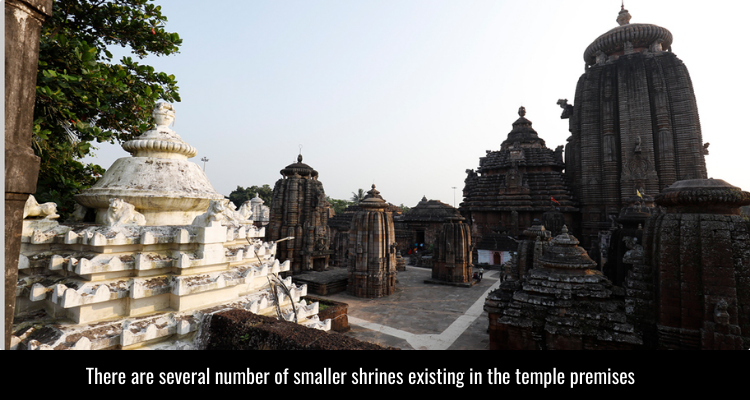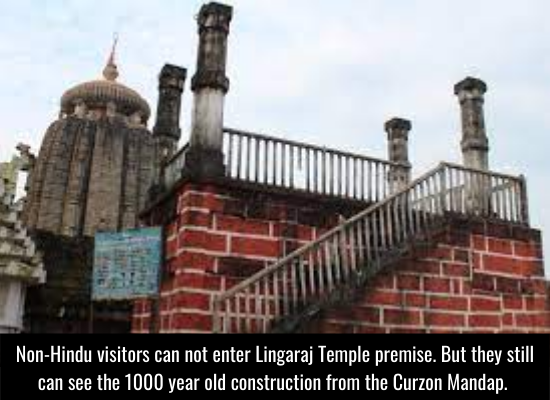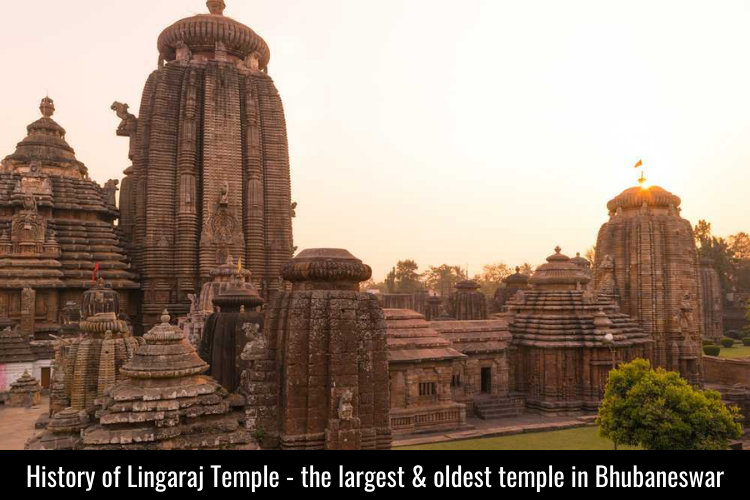Lingaraj Temple is one of the famous historical and religious landmarks of Bhubaneswar city in Odisha. Built in 11 century CE, the eminent Hindu temple also counts among the oldest temples in India. Billions of devotees still gather every year to worship Lord Lingaraj, the principle deity of the temple. World famous historian James Fergusson, had pointed the temple as ‘one of the finest examples of purely Hindu temples in India’.
Keshari Jajati of Somvanshi dynasty had built Lingaraj Temple in 11th century. According to the Brahma Purana, King Yayati Keshari had shifted his capital from Abhinava Yayatinagar to Ekamra Kshetra, present Bhubaneswar. But some of the temple constructions belong to 6th century CE. King Jajati may have constructed Lingaraj Temple on an already existing 6th century temple.
The conviction of Lord Shiva & Vishnu being one soul, is typically visible here. Lord Lingaraj is often called as ‘Harihar’. The word ‘Hari-Har’ actually points the two principle deities of Hinduism, Lord Vishnu (Hari) and Lord Shiva (Har). Despite the Somvanshi dynasty was a devotee of Shaivism, Lingaraj temple is carrying a classical mix of Shaivism and Vaishnavism.
Lingaraj Temple Authority manages the day to day activities. But Archeological Survey of India (ASI) takes care of the overall site.
Somvanshi dynasty: Founder of Lingaraj Temple
Lingaraj Temple history dates back to 11th century CE, when Somvanshi dynasty was ruling ancient Kalinga region.
Somvanshi dynasty was actually a Rajput dynasty, often referred as Lunar dynasty or Keshari dynasty. It ruled in large part of Kalinga or present state of Odisha from 9th to 12th century. Yayatinagar (present day Binka) and Abhinava Yayatinagar (presently Jajpur) were the two capital cities of Somvanshi empire. Somvanshi kings were followers of Shaivism. The main deity of the temple, Lingaraja, is a form of Lord Shiva only.
King Yayati (or Jajati) was also famous for introducing new Somvamshi Temple Architecture. The rulers of Somvamshi dynasty later built many temples including Lingaraj Temple of Bhubaneswar.
History of Lingaraj Temple
Ekamra Purana, the 13th century treatise has several mention about some important history of Lingaraj Temple. Several copper and stone inscriptions also indicate that the largest temple of Bhubaneswar did exist in 11th & 12th century. Although, there is also no doubt that some part of the temple is 6th century construction, but early history of Lingaraj Temple is quite uncertain.
Several theories exist on the early history of Lingaraj Temple, especially on its construction in 6th century CE. James Fergusson credits King Lalat Indu Keshari (615 – 657 CE) who may had initiated the initial construction of Lingaraj Temple. But a lot of historians differ to the theory as well.
However, the present form of Lingaraj Temple was definitely constructed in 11th century. The main structures of Lingaraj Temple, including the Vimana and Jagamohana are certainly 11th century Somvanshi Temple Architecture. However, Natamandira and Bhoga-mandapa are the 12th century constructions. In early 12th century, reign of Ganga (Chodaganga) dynasty started in the area. But, Ganga kings being the followers of Vaishnavism, they began construction of Jagannath Temple of Puri in 12th century.
Lingaraj Temple Architecture
Somvanshi Temple Architecture, a unique form of Kalinga Architecture reflects in all the major structures inside Lingaraj Temple. Typically, Kalinga Architecture was one of the finest old temple architectures of India, visible in Odisha. It is a combination of four different type of structures built on east-west axis, also known as Deula style.
Vimana or Bada Deul, the tallest structure containing the sanctum appears at the back. It also contains the main temple sanctum. Jagamohana or the assembly hall is the second tallest structure appreas just before Vimana. Natamandira or the festival hall is slightly shorter in height and shows up in front of Jagamohana. Bhoga-mandapa or the hall of offerings comes right in front of all three structures. Similar Kalinga Architecture is visible both at Lingaraj Temple and Puri Jagannath Temple.

The largest temple of Odisha has a surrounding boundary wall of 520 feet long and 465 feet wide; with 7.5 feet thickness. Temple height is about 55 meters. A huge sandalwood gate at the entrance is another typical Lingaraj temple beauty.
All structures were built with sandstones of darkest shade, another uinqueness of Lingaraj Temple architecture. Visitors can fulfil their desired Lingaraj darshan inside this Garbhagriha.

There are several other smaller shrines appear surrounding the main temple structures. All the deities of these shrines are worshipped on daily basis. Among them temple of Lord Kartikay, Devi Sheetla, Devi Santoshi, Lord Ganesh, Devi Parvathi, and others are also enhancing beauty of the temple complex. Some of these shrines are much older, depicting ancient temple architectures compared to other structures of Lingaraj Temple.
Lord Curzon Mandap
Since only Hindu devotees can enter the temple premises, British Viceroy Lord Curzon ordered the construction of a temple viewing platform. Non-Hindu tourists can leverage the opportunity to visit one of the oldest historical constructions of Odisha from here. It exists at the north gate of the temple and precisely is the best viewing point for non-Hindu tourists. The platform is also known as Curzon Mandap or Lord Curzon viewing tower.

Major Festivals
Mahashivaratri
Shivaratri or Mahashivaratri is one of the most famous festivals in India. Devotees believe that Lord Shiva married goddess Parvati on this day. But there is a different legend here. People believe that, on the night of Mahashivaratri, Lord Shiva had killed a demon.
On usual days, the average visitor count is about 6,000. But during Mahashivratri , more than 200,000 devotees gather at the Lingaraj Temple.
Chandan Yatra
A holy celebration of the Lord Lingaraj and his sandal voyage (Chandana Yatra). The ceremony continues for 42 days long, perhaps the longest festival in Odisha. During these days devotees and the Shivaites of the temple smear the deity with Sandalwood powder. Also the deity goes for a boat ride in the Bindusagar lake.
Rathayatra
The preparation of Rathyatra starts after Chandan Yatra. The intensity of Rathayatra may not as high as of Puri Rathayatra festival; but it also has a great significance in terms of popularity. Priests prepare offerings like Ballabha Bhoga, Sakala Dhupa, Bhanda Dhupa etc during Rathayatra.
Lingaraj Temple Darshan
Entry Timings
Lingaraj Temple entry timings are pretty flexible. The temple opens at 2:00 AM early morning and remains open till 10:30 PM. However, there is a break between 12:00 PM and 03:00 PM when Lingaraj Temple Darshan is restricted. Otherwise, devotees can visit the temple for Lord Lingaraj Darshan on all 7 days in a week.
Entry Fees
Lord Lingaraj Darshan is completely free. The temple authority doesn’t charge any fees to enter temple premises. However mobile phones, shoes or any other leather items are not allowed inside the temple premise. Photography or videography is also not allowed inside Lingaraj Temple.
Entry gates of Lingaraj Temple
Simha Dwara or ‘Lions gate’ is the main entrance of Lingaraj Temple which appears on the east side. There is a smaller entrance gate is available on the north, but mostly remains closed.
Entry Restrictions
Lingaraj Temple is one of the pure Hindu temples of India. It doesn’t allow any non-Hindu pilgrims to enter the temple premises. Further, temple authority also does not allow children to enter the temple.
Lingaraj Temple FAQ
Temple opens its gate at 6 AM for devotees. It remains open till 9 pm at night. However, the temple closes it’s gate once more during the day between 12 noon to 3:30 PM. This happens for the priests to perform Mahasnana for the deities.
The Garbhagriha, however, closes at 8:30 PM to prepare it for next day rituals.
No. Unfortunately, camera & other electronic gadgets are not allowed inside the temple premises.
There are 3 railway stations which are very close to the Lingaraj Temple.
1. Lingaraj Temple road station: 2.4 kilometers, about 7 minutes drive to the temple.
2. Bhubaneswar railway station: 5.1 kilometers, about 15 minutes drive to the temple.
3. Sarkantra railway station: 5.8 kilometers, about 18 minutes drive to the temple.
Biju Patnaik International Airport (BBI), Bhubaneswar is just 4.5 kilometer away from the Lingaraj Temple. It takes about 10 minutes drive to the temple.
No. Unfortunately, non-Hindus are not allowed to enter the temple premises. However, people can observe the temple from the temple viewing point from outside.



Pingback: History of Puri Jagannath Temple, Odisha - History Finder
Pingback: Konark Sun Temple with exquisite sculptures - History Finder